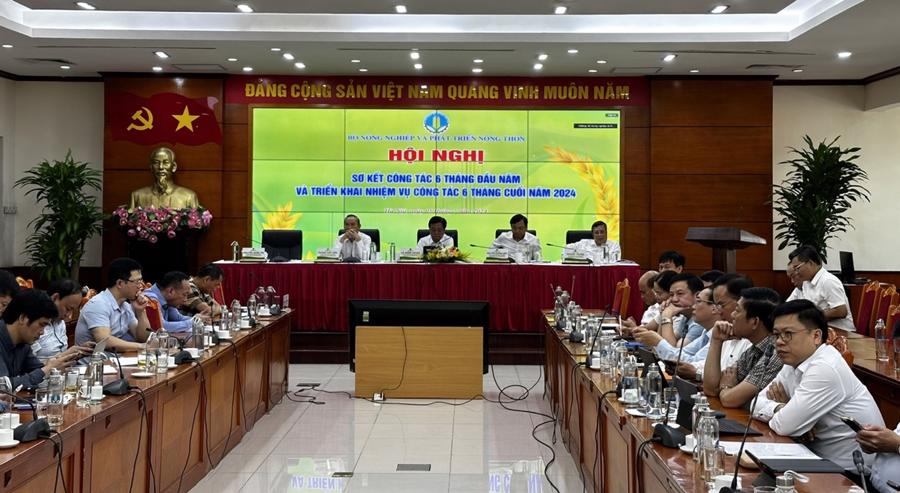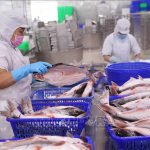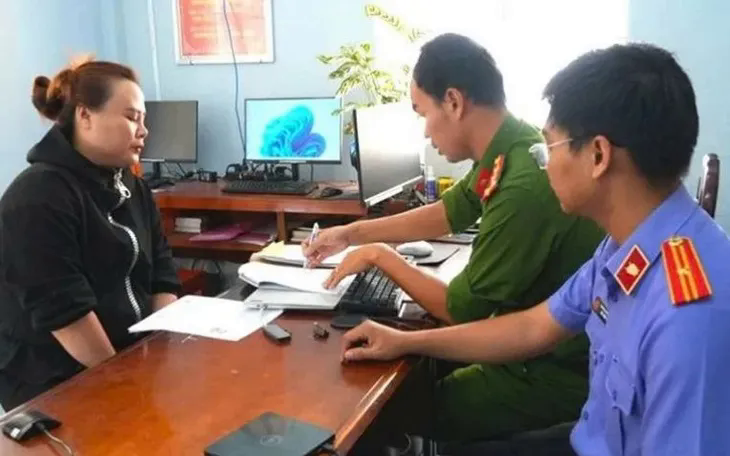According to a report presented at the mid-year review conference for the agriculture, forestry, and fisheries sector, held by the Ministry of Agriculture and Rural Development on July 5, 2024, the growth rate of GDP in the agriculture, forestry, and fisheries sector for the first half of 2024 reached 3.38%, the highest in the last five years for the same period (GDP growth rates for the first half of the previous years: 2020 – 1.24%, 2021 – 3.77%, 2022 – 2.78%, and 2023 – 3.26%).
MANY FIELDS EXCEEDING EXPECTATIONS
Cumulative rice cultivation area from the beginning of the year until now totals 5.03 million hectares, a <0.9% increase compared to the same period last year; the harvested area reached 3.48 million hectares, a 0.5% increase; and the average yield was 67.1 tons/hectare, a 0.7-ton increase. As of now, the rice production from the harvested area is 23.3 million tons, a 1.6% increase compared to the same period last year.
Regarding the implementation of the Project “Sustainable development of one million hectares of high-quality and low-emission rice cultivation towards green growth in the Mekong Delta until 2030”, the Ministry of Agriculture and Rural Development has issued and organized training on technical processes for low-emission rice cultivation for five localities piloting the model. At the same time, a decree on the pilot mechanism for result-based payment for emission reduction and financial management agreement for greenhouse gas emission reduction payment is being built.

In the livestock sector, compared to the same period last year, the output of pork reached 2.54 million tons, a 5.1% increase; poultry meat output reached 1.21 million tons, a 4.9% increase; eggs reached nearly 10.1 billion, a 5.1% increase; beef output reached 255.9 thousand tons, a 1.1% increase; and milk production reached 643.7 thousand tons, a 5.5% increase.
In the first half of 2924, agricultural GDP increased by 3.15%; forestry GDP increased by 5.34%; and fisheries GDP increased by 3.76%. The total export turnover of the agriculture, forestry, and fisheries sector in the first six months reached 29.2 billion USD, a 19% increase compared to the same period in 2023.”
In the forestry sector, during the first six months, the country prepared 593 million seedlings of various types to serve forest planting, with a concentrated new forest planting area of 125.5 thousand hectares, a 1.2% increase compared to the same period last year. Additionally, there has been a focus on improving productivity and quality of forests, with attention to seed management (the proportion of forest area planted from controlled-quality seed sources reached 85%), and a shift towards intensive forest cultivation, converting commercial forests with small timber to large timber. In the first six months, the volume of timber harvested from concentrated forest plantations reached 9.93 million m3, a 6.3% increase. Notably, the GDP growth rate of the forestry sector in the first half of this year reached 5.34%, the highest among the agriculture and fisheries sectors.
In the first six months, the total fisheries output reached 4.38 million tons, a 2.7% increase compared to the same period in 2023. The salt production area was 10,804 ha, and the output was 789.2 thousand tons.
As of the end of June 2024, about 78% of communes nationwide have achieved new rural standards; among them, 2,115 communes have achieved advanced new rural standards (an increase of 503 communes compared to the end of 2023), and 463 communes have achieved typical new rural standards (an increase of 207 communes). There are 22 provinces and cities with 100% of communes meeting the new rural standards, an increase of 4 provinces compared to the end of 2023. Thus far, 13,368 products have been recognized under the “One Commune, One Product” (OCOP) program with a 3-star rating or higher, an increase of 2,312 products compared to the end of 2023, with the participation of 7,425 entities.
To stabilize and prevent a sudden increase in the prices of agricultural products and input materials in the context of the minimum wage increase from July 1, 2024, the Ministry has promptly advised the Government and the Prime Minister on directing solutions to promote the development of production, processing, consumption, and export of agricultural, forestry, and fisheries products.
Along with that, the Ministry has completed and submitted to the Prime Minister for issuance of Decision No. 145/QD-TTg dated February 2, 2024, on the Plan for implementing the Master Plan for Disaster Prevention and Control and Irrigation for the period of 2021 – 2030, with a vision to 2050. On the other hand, the Ministry is in the process of finalizing the Project “Ensuring water security and dam and reservoir safety for the period up to 2030, with a vision to 2045”.
TRANSFORMATION FROM AGRICULTURAL PRODUCTION TO AGRICULTURAL ECONOMY
Along with the achievements mentioned above, Mr. Phung Duc Tien, Deputy Minister of Agriculture and Rural Development, pointed out that the sector still faces certain shortcomings, limitations, and challenges. Natural disasters, diseases, droughts, saltwater intrusion, water shortages for production, forest fire prevention, and environmental pollution are among the significant challenges.
Agricultural production in the Mekong Delta, Central Highlands, and South Central Coast regions is facing difficulties due to drought and increasing saltwater intrusion.
Quality management and food safety issues still arise, with violations occurring in some food production and business establishments, causing public backlash.
The illegal import of livestock products across borders and the transportation of unidentified livestock and poultry affect production and business regulation and control, pose risks of disease transmission, and impact farmers’ incomes and enterprises’ profits. Linkages in the value chain to promote mechanization and the application of high technology to reduce intermediary costs and increase added value are not yet widespread.
“”We strive for the whole year of 2024 to achieve a GDP growth rate for the entire sector of 3.2 – 4.0%, in which the value of crop production increases by 2.0 – 2.2 %; the value of livestock production increases by 4.0 – 5.0%; the value of fisheries production increases by 3.7 – 4.0%; and the value of forestry production increases by 5.0 – 5.5%.”
Mr. Le Minh Hoan, Minister of Agriculture and Rural Development.
Chairing the conference, Mr. Le Minh Hoan, Minister of Agriculture and Rural Development, stated that with the results achieved in the past six months, the Ministry has raised some targets higher than the ones assigned by the Government at the beginning of the year. Specifically, the target for agricultural, forestry, and fisheries export turnover has been raised to 57-58 billion USD (the target set by the Government at the beginning of the year was 55 billion USD).
Minister Le Minh Hoan emphasized, “There must be a consistent transformation in both mindset and actions towards an agricultural economy; we must uphold the Government and Prime Minister’s guiding principle for 2024: “Discipline, responsibility, proactive response, accelerated innovation, and sustainable development.” A shift in mindset is necessary, from focusing on yield to emphasizing added value; from increasing production volume to enhancing value to better meet domestic consumption and export demands; and from a single-layer to a multi-layered, multi-value approach for a given land area.
With this in mind, the Minister requested that the agencies under the Ministry be resolute in their leadership and coordination and strengthen collaboration by promoting the use of information technology and digital technology, especially in directing solutions to cope with droughts and saltwater intrusion. Choosing breakthrough solutions to guide production is crucial, such as opening up export markets while also prioritizing the domestic market, applying good production processes, ensuring safety and quality, etc.
“It is essential to enhance forecasting and warning capabilities, closely follow the practical situation, and proactively develop scenarios and provide early directions to prepare for any possible eventualities,” emphasized Minister Le Minh Hoan.
Export of agricultural, forestry, and aquatic products increases by over 79%
According to the Ministry of Agriculture and Rural Development, in January 2024, the total export turnover of agriculture, forestry, and fisheries reached $5.14 billion, a 79.2% increase compared to the same period last year; while the import value was $3.72 billion. Therefore, the agriculture, forestry, and fisheries sector achieved a trade surplus of over $1.4 billion in the first month of 2024, a more than 4.6-fold increase compared to the same period last year.














